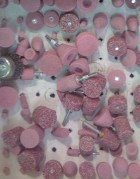Project Rational
CNC bits industries provide any array of tools (bits) for different type of routing and milling jobs. In the routing approach, bits are designed for performing a linear subtraction that is dictated by shape and not necessarily pattern (Image 1). In milling the action occurs directly on the surface of the material, which can be wood, metal or similar). In those cases the material density dictates the bit selection.
The ability to choose customized bits is limited to a narrow selection criteria’s— there is a bit for a strategy (mill, route) and material (density etc….) but there is no option to customize the bits with additional criteria’s.
Within this scope my project will focus on the relationship between bit configuration and pattern(s). In doing so it will broaden the selection criteria of bits to meet a wider range of outcomes. Optimally customization will occur via an interface that will visualize the tool and then output a fabrication file to be prototyped on a 3d printer. Ultimately the 3d print will serve as a mold for high end bit that will be manufactured by a third party or directly in a Fab Lab facility.
Here patterns are referred too as any desired effect that the bit can have on the material. More specifically it is intended to question the distinction in end result comparing circular patterns with linear one. The other variable will be the bit’s configuration. I have noticed that if the same bit is used there will be slight differentiation between the results. This is also true to material (same pattern on different material will manifest itself differently). Hence including bit’s configuration as way to optimize result can aid in the adaption of a proper tool that in return will enhance a clear correlation between bit and pattern.
When testing this correlation evidence shows that if the same bit is used there will be slight differentiation between the results (clarify this thougt). This is also true to material (same pattern on different material will manifest itself differently.
Method
In my methodology I will study and analyze
1. The affect of bit configuration (bit type) on desired outcome. This will enable me to index a list parameters that will affect that configuration (image 2)
2. The possibilities of printing bits on the makerbot, optimizing the print result so to achieve material strength. In parallel I will explore other fabrication technique – such as laser cutting (assemble of a bit out of flat pieces – if possible at all)
3. The bits on soft material such as foam, sand, or similar.
4. If successful in establishing a correlation between bit configuration and desired result. I will explore what are the possibilities for fabricating bits that can be used to mill harder materials
5. If not I will concentrate on customizing bits for soft material
Objective
1. To provide wider criteria for bit selection
2. Develop a design interface (file to factory) that will allow Makers to customize and fabricate bits.
Image 1
Image 2
Bit Vocabulary
- Chamfer router bits – Chamfer bits cut angles and shapes in the edge of materials. This is a great bit for the handyman wishing to create decorative pieces or edging.
- Edge-forming router bits – For those with an especially skilled hand, edge-forming bits help with intricate edging tasks.
- Flush trim router — This type of bit has a giveaway name. They are used to make the edge of one material flush with another, like trim.
- Joinery bits – These bits can be found in just about any shape and size, making them perfect for joining two separate materials together.
- Rabbeting router bits — Rabbeting bits can be purchased in sets. They’re most commonly used to notch the edge of your building supplies. They cut vertically and horizontally at the same time.
- Raised panel bits are most often used on door panels. They go hand in hand with stile and rail bits.
- Stile and rail bits – These bits are great for projects involving framework or panel doors.
- Straight router bits — These bits are a must have for anyone with a router. These common bits are used for straight down cuts or to form grooves or dados.



